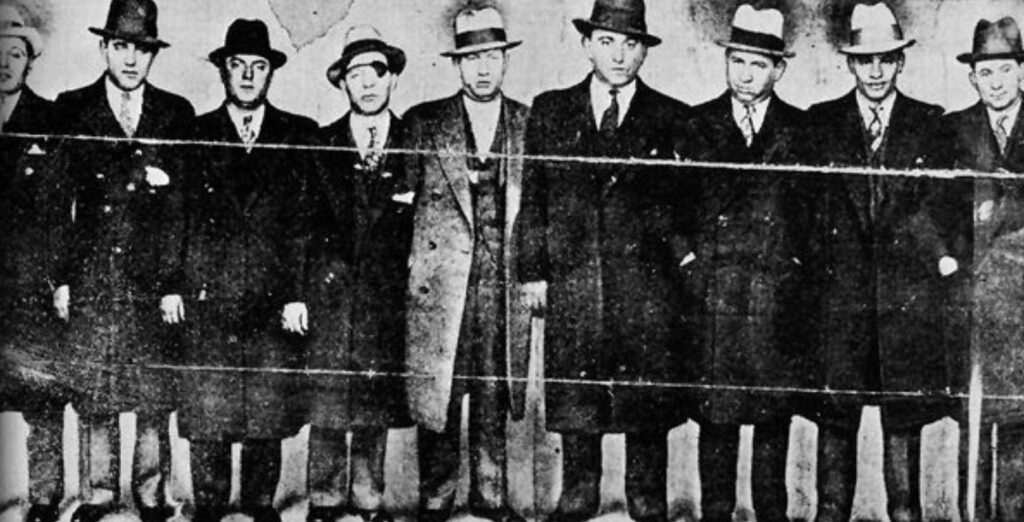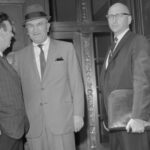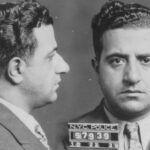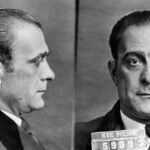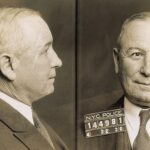In the annals of American crime history, few names evoke as much dread as Murder, Inc. This notorious group served as the enforcement arm for the Italian-American Mafia and the Jewish mob during the 1930s and 1940s. With a reputation for brutality and efficiency, they were the go-to solution for organized crime leaders who needed to eliminate obstacles—be they people or problems. This article delves into the formation, operations, key figures, and ultimate downfall of Murder, Inc., providing a comprehensive look at this dark chapter in American history.
The Birth of a Killing Machine
Murder, Inc. emerged from the gritty streets of Brownsville, Brooklyn, not as a structured entity but as a volatile amalgamation of lethal skill sets. The architects behind this fearsome group were none other than Louis “Lepke” Buchalter and Albert Anastasia, both of whom were already deeply entrenched in the criminal underworld. Buchalter, known for his cunning manipulation of labor unions, and Anastasia, a feared figure in the Mafia, found a symbiotic relationship in their shared need for a specialized force capable of extreme violence. This wasn’t a mere side project for them; it was a calculated move to create an enforcement arm that would act as the sword and shield for their sprawling criminal enterprises. The duo meticulously selected individuals who were not only proficient in the art of killing but also demonstrated a certain moral flexibility that allowed them to carry out orders without question. In doing so, they created a group that would become the epitome of organized crime’s violent tendencies.
The Brownsville Epicenter
At first glance, the 24-hour coffee shop and candy store at the intersection of Saratoga and Livonia Avenues in Brownsville seemed like any other neighborhood establishment. However, this unremarkable location was the pulsating heart of Murder, Inc.’s operations. It was here that the group’s members would receive their deadly assignments, often relayed through coded language or subtle gestures that only they could understand. The shop acted as a sort of criminal stock exchange, where information, orders, and payments were discreetly exchanged under the guise of everyday transactions.
But the coffee shop was more than just a meeting place; it was a symbol of the audacity of Murder, Inc. Operating in plain sight, the group leveraged the anonymity provided by the bustling neighborhood to conduct its nefarious activities. The orders for hits didn’t just originate from Buchalter and Anastasia; they were also commissioned by other high-ranking figures in the criminal underworld. Names like Lucky Luciano, the strategic genius behind the modern Mafia, Meyer Lansky, the financial wizard who laundered vast sums of money, and Dutch Schultz, the notorious bootlegger, were all part of this intricate web of organized crime. Each had their own vested interests and territorial disputes, making Murder, Inc. the go-to problem solvers. The coffee shop in Brownsville thus became the epicenter of a complex network of criminal activities, a place where life and death decisions were made over cups of coffee and innocuous chit-chat.
The Ethnic Divide – Jews and Italians
Murder, Inc. didn’t just randomly assemble a group of killers; it orchestrated a meticulously planned ethnic divide that served as both a shield and a sword. Jewish enforcers like Abe “Kid Twist” Reles and Harry “Pittsburgh Phil” Strauss were not merely chosen for their ruthlessness but also for their ability to navigate the complex social landscapes of their own communities. This was a tactical maneuver aimed at reducing the visibility of the group’s activities. Operating within their own ethnic circles allowed these hitmen to exploit community-specific knowledge, from understanding local dialects to knowing the back alleys like the palms of their hands.
The Italian faction within Murder, Inc. operated with similar precision but within their own cultural context. The Mafia, with its own set of rules and codes of conduct, required enforcers who understood the subtleties of honor and loyalty within the Italian-American community. This ethnic segmentation was far from a mere operational detail; it was a cornerstone of the group’s strategy. It allowed Murder, Inc. to operate like a chameleon, blending seamlessly into different communities while carrying out their deadly assignments. This ethnic division also served another purpose: it created a buffer against law enforcement. Detectives found it challenging to penetrate these tight-knit communities, further shielding the group from scrutiny.
Tools of the Trade
The term “tools of the trade” takes on a darkly literal meaning when discussing Murder, Inc. This was a group that turned killing into a form of grim craftsmanship, employing an array of methods that would both accomplish the task and send a message. Ice picks were not just weapons; they were instruments of terror, often used to target specific body parts to maximize pain before death. Garrotes, on the other hand, were employed for their silence and efficiency, ideal for hits that required a stealthy approach. Shotguns were the tools for making grand statements, often used in public executions that were meant to send shockwaves through rival factions.
But the tools were just one part of the equation. The real genius lay in the planning and execution. Stolen cars fitted with counterfeit license plates became mobile bases of operation, often loaded with an array of weapons to suit any contingency. Trailing vehicles were not just getaway cars; they were tactical units equipped to block police or rival gang members who might attempt a pursuit. Once a hit was completed, an elaborate cleanup process was initiated. Weapons were dismantled and discarded, cars were abandoned and set ablaze, and clothing was often burned to eliminate any trace of evidence. This wasn’t just about avoiding capture; it was about erasing the very existence of the act, as if to mock the efforts of law enforcement agencies desperate to bring them to justice. The chilling efficiency with which Murder, Inc. operated made them not just feared but almost mythical in their invincibility.
High-Profile Hits
Murder, Inc. didn’t just handle run-of-the-mill hits; they were the architects behind some of the most high-profile assassinations in the annals of American organized crime. Take, for example, the meticulously planned execution of Dutch Schultz. Schultz wasn’t just another name on a hit list; he was a high-stakes liability. His audacious plan to assassinate Thomas Dewey, the New York Special Prosecutor hell-bent on dismantling organized crime, was a ticking time bomb that threatened to bring unprecedented heat on the entire underworld. The decision to eliminate Schultz wasn’t made lightly; it was the result of intense deliberations among the syndicate’s top brass, who weighed the pros and cons before reaching a chilling consensus.
The execution itself was a masterclass in precision and timing. Schultz and his inner circle were not merely killed; they were eliminated in a manner that sent ripples through the criminal underworld. This was a message wrapped in an execution, a stark warning to anyone who dared to act against the interests of the syndicate. The hitmen chosen for this task were not random enforcers but specialists in high-profile assassinations, individuals who understood the nuances of public perception and the importance of sending a clear, unequivocal message. In the aftermath, the syndicate made sure to distance themselves from the act, employing a series of diversions and misinformation tactics to keep law enforcement off their trail. The Schultz hit wasn’t just an assassination; it was a carefully orchestrated operation that showcased Murder, Inc.’s unparalleled expertise in the dark arts of organized crime.
The Informant – Abe “Kid Twist” Reles
Abe “Kid Twist” Reles was not just another member of Murder, Inc.; he was a linchpin, a man whose actions would set off a chain reaction that led to the group’s downfall. Reles knew the inner workings of the organization like no one else, having been deeply involved in its operations from the early days. His decision to cooperate with law enforcement wasn’t a spur-of-the-moment act but a calculated move made under the looming shadow of impending indictments and the very real threat of execution.
Reles’ testimony was a treasure trove for prosecutors, offering an insider’s view into the labyrinthine operations of Murder, Inc. His words were not just statements; they were guided missiles aimed at the heart of the syndicate. The most significant casualty of his betrayal was Louis “Lepke” Buchalter, who found himself in the unenviable position of being the only major organized crime leader to be executed in the United States. But Reles’ impact extended beyond the courtroom; his defection sent shockwaves through the underworld, shattering the previously unbreakable code of silence that had protected the group for years.
The fallout was immediate and far-reaching. Trust within the organization eroded, leading to internal conflicts and power struggles that further weakened the syndicate. Reles’ cooperation also emboldened other potential informants, creating a domino effect that led to additional arrests and convictions. Yet, even as he aided law enforcement, Reles himself became a victim of the very machine he helped dismantle. His mysterious death while under police protection remains a subject of speculation, adding yet another layer of intrigue to the already complex narrative of Murder, Inc.
The Downfall and Legacy
The downfall of Murder, Inc. was not a sudden implosion but a gradual erosion, meticulously orchestrated by Assistant District Attorney Burton Turkus. Turkus was not just a prosecutor; he was a relentless hunter, meticulously gathering evidence, flipping witnesses, and building a case that would withstand the scrutiny of the courts. His efforts culminated in a series of high-profile trials in the late 1930s and early 1940s, which saw key members of Murder, Inc. being led to the electric chair at Sing Sing prison. This was not just a legal victory; it was a societal one, signaling the end of an era where organized crime operated with near impunity.
Yet, the story of Murder, Inc. is far from a closed book. The mysterious death of Abe Reles, the linchpin informant, while under police protection, adds a layer of complexity to the narrative. Was it an accident, a suicide, or an inside job orchestrated by remnants of the syndicate he betrayed? His untimely demise not only fueled a plethora of conspiracy theories but also had tangible repercussions. Several ongoing investigations lost their momentum, key witnesses became reluctant to cooperate, and a shroud of uncertainty descended upon the legal proceedings. Reles’ death served as a chilling reminder that even in its weakened state, the specter of Murder, Inc. could still reach out and touch lives, sowing doubt and fear in its wake.
Conclusion
The tale of Murder, Inc. is not just a series of events relegated to history books; it’s a cautionary tale that continues to reverberate through the corridors of American society and law enforcement. The group may have been dismantled, but its methodologies, its audacity, and its sheer ruthlessness have become subjects of intense study and discussion. Criminologists, sociologists, and historians alike dissect the operations of Murder, Inc. to understand the anatomy of organized crime, the social conditions that allow such entities to flourish, and the systemic challenges that hinder their eradication.
The legacy of Murder, Inc. also serves as a litmus test for law enforcement agencies, a constant reminder of the uphill battle they face in combating organized crime. The group’s ability to operate in plain sight, to infiltrate communities, and to corrupt institutions highlights the vulnerabilities within the system. As we reflect on this dark chapter, we are forced to confront uncomfortable questions about the resilience of criminal enterprises and the societal factors that enable them. The story of Murder, Inc. is not just a historical account; it’s an ongoing dialogue, a set of unresolved questions that challenge our perceptions of justice, morality, and social order.

